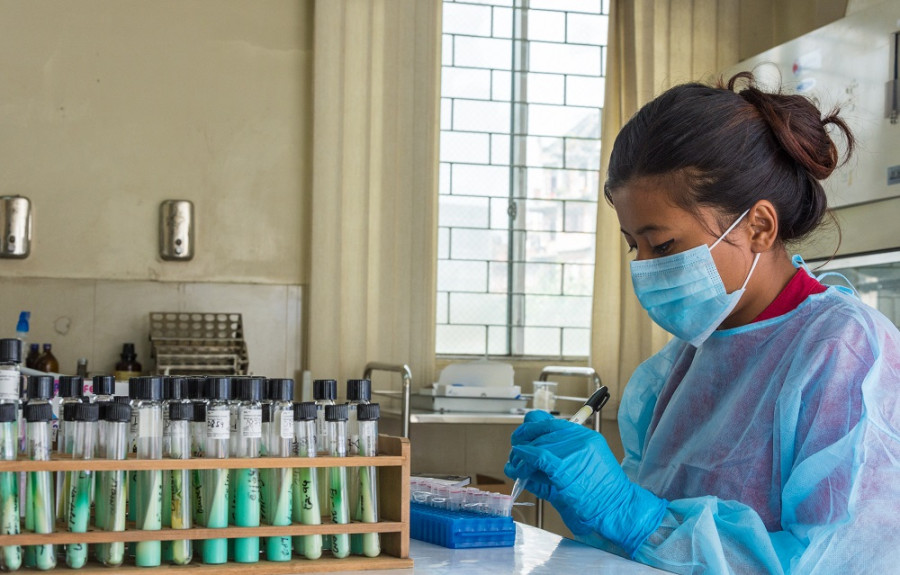Health
Nepal set to miss target of ending tuberculosis by 2035
Experts warn of catastrophic condition in coming years if immediate steps are not taken.
Arjun Poudel
A report of a prevalence survey carried out by an independent Joint Monitoring Mission for tuberculosis has painted a bleak picture of the country’s tuberculosis control effort.
The report, a copy of which is obtained by the Post, states that Nepal is “not on track to end tuberculosis by 2035”. At the United Nation’s high-level meeting on TB in 2018, Nepal had committed to ending the problem through the WHO END TB Strategy.
Read: Tuberculosis centres across country lack reagent for test
The monitoring mission comprising national and international experts, implementing partners and officials from development agencies, had reviewed the progress, challenges and plans for the country’s tuberculosis control efforts.
“Nepal is not on track to meet these commitments,” reads the report. “So honouring them, and meeting the milestones and targets of the End TB Strategy, will require implementing bold policies that guarantee access to high-quality TB care and prevention to all who need it.”
The report states that “business as usual” is not an option—it will lead to a disintegration of the national tuberculosis programme that radical changes are needed.
Dr Kedar Narsingh KC, a TB and chest physician, blamed the government for failing to implement strategies. “Our government has signed almost every international commitment but it has does little to implement them,” said KC. “If immediate intervention measures are not taken, we can witness a catastrophic condition in the next couple of years.”
Read: Health Ministry launches detection programme to curb tuberculosis spread
The report has stressed the need to address health system weaknesses, including those exacerbated by
federalisation, and significantly increase investment in TB elimination by the government and development partners.
According to the report, TB in Nepal is significantly larger than previously thought—two-thirds greater than previously estimated, which increases the number of “missing cases” significantly.
In 2017/18, 32,474 people were diagnosed with TB, and nearly 7,000 people were estimated to have died (using pre-prevalence survey estimates). TB affects any age, caste or class, but cases are mainly poor people and mostly men.
Children comprise 34 percent of the population but are currently under-diagnosed with TB. Likewise, the number of MDR cases each year may be as high as 1,500, of which only 546 were diagnosed and treated in 2016/17. HIV is a risk factor for TB, but the prevalence of HIV is falling, and it is not presently the problem it once was.
What is alarming is the massive economic burden that the disease has on patients. According to the report, the monitoring mission had met 22 patients who had spent over Rs45,000 in search of effective treatment of tuberculosis, while, as per the government commitment, it should have been easily available.
Read: Chances of tuberculosis spread high in prisons, officials say
The average cost to a family of any member with TB can amount to as much as 39 percent of annual household expenditure, a catastrophe for an impoverished family.
Likewise, the report also highlighted the drawback in the TB control programmes by the ongoing employee adjustment process in all three tiers of government—federal, provincial and local level.
The report says the National Tuberculosis Control Centre’s technical staff have been hollowed out.
“Federalisation now threatens the integrity of the centre. Districts, central to global TB control strategies, have been abolished and then reinstated, but they have far fewer staff than they did earlier,” states the report. “Experienced district and regional TB staff have already been transferred. Most staff responsible for TB activities in the provinces and local level are not trained to carry out the work.”
Dr Sagar Kumar Rajbhandari, director at the National Tuberculosis Control Centre, said his office has been working to formulate a new strategy (2021-2025), incorporating the recommendations of the high-level mission.
“We are committed to implementing all the recommendations of the mission,” said Rajbhandari. “We have already started some works as per the recommendations.”
The recommendations made by the mission include ensuring essential functions of TB control, especially laboratory network and quality assurance; supportive supervision; surveillance; monitoring and evaluation; procurement; active case detections among others.
The new five-year strategic plan’s modality, however, is unclear. According to the report, the National Strategic Plan (2016-2021) is underfunded. More importantly, disbursement of the annual allocated budgets has been just 67 percent, states the report. “In consequence, the national strategic plan has been only partially implemented. Of the activities in the plan, 48 percent have been completed, 17 percent are partially implemented, and 36 percent have not been started, largely through lack of funding and staff.”
According to Dr KC, multi-drug resistance (MDR) TB cases have risen by 15 percent, which was less than 2 percent in the past.
He said channels of new case finding and reporting have been disrupted by the implementation of federalism.
“One TB patient transmit the deadly disease to 10 people and over 12,000 cases are missing every year, which is alarming,” said Dr KC. “Concerned agencies including the Ministry of Health and Population have not taken the issue seriously.”




 14.81°C Kathmandu
14.81°C Kathmandu














